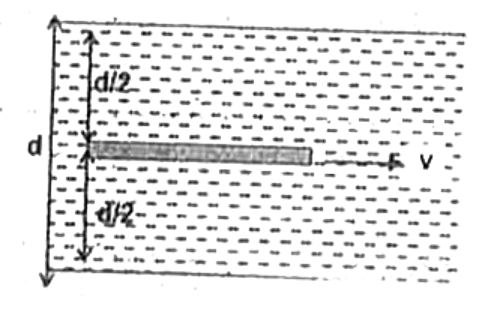A square plate of 1m side moves parallel to a second plate with velocity 4m/s. A thin layer of water exist between plates. If the viscous force is 2N and the coefficient of viscosity is 0.01 poise then find the distance between the plates in mm.
F=ηAvd⇒d=ηAvF=0.01×10−1×12×40.002=2m
Topper's Solved these Questions
- ELASTICITY, SURFACE TENSION AND FLUID MECHANICSBOOK - ALLENCHAPTER - ELASTICITY, SURFACE TENSION AND FLUID MECHANICSEXERCISE - Exercise 1 (Elasticity)
16 Videos
- ELASTICITY, SURFACE TENSION AND FLUID MECHANICSBOOK - ALLENCHAPTER - ELASTICITY, SURFACE TENSION AND FLUID MECHANICSEXERCISE - Exercise 1 (Surface Tension)
21 Videos
- CENTRE OF MASSBOOK - ALLENCHAPTER - CENTRE OF MASSEXERCISE - EXERCISE-V B
19 Videos
- ERROR AND MEASUREMENTBOOK - ALLENCHAPTER - ERROR AND MEASUREMENTEXERCISE - Part-2(Exercise-2)(B)
22 Videos
Similar Questions
A square plate of 0.1 m side moves parallel to a second plate with a velocity of 0.1m/s, both plates being immersed in water. If the viscous force is 0.002 N and the coefficient of viscosity is 0.01 poise , distance between the plates in m is
View SolutionA square plate of 0.1 m side moves parallel to another plate with a velocity of 0.1ms−1 both plates immersed in water. If the viscous force is 0.02 N and the coefficient of viscosity 0.01 poise, what is the distance apart?
View Solution
Knowledge Check
A square plate 0.1 m side moves parallel to second plate with a velocity of 0.1ms−1, both plate being immersed in water .If the viscous force is 0.002 N and the coefficient of viscosity 0.001 poise, distance between the plate is
A0.1 mB0.05 mC0.005 mD0.0005 mA square plate 0.1 m side moves parrarel to second plate with a velocity of 0.1ms−1 ,both plate being immersed in water .If the viscous force is 0.002 N and the cofficient of viscosity 0.001 poise, distance between the plate is
A0.1 mB0.05 mC0.005 mD0.0005 mThe distance between the plates of a parallel plate condenser is 4mm and potential difference is 60 volts. If the distance between the plates is increased to 12mm, then
AThe potential difference of the condenser will become 180 voltsBThe potential difference will become 20 voltsCThe potential difference will remain unchangedDThe charge on condenser will reduce to one third
A square metal plate of 5 cm side is moving parallel to another plate with a velocity of 10 cm/s. Both the plates are immersed in water. If the viscous force is 300 dyne and viscotity of water is 0.01 poise, then calculate the distance between the paltes.
View SolutionA squre metal plate of 10cm side moves parallel to another plate with a velocity of 10cms−1, both plates immersed in water. If the viscous force is 200 dyne and viscosity of water is 0.01 poise, what is their distance a part.
View SolutionA square plate of 20 cm side moves over another plate with velocity 5cms−1, both plates immersed in water. If the viscous force is 0.205gf and viscosity of water is 0.01 poise, what is the separation between the plates?
View SolutionA Square metal plate of side 10 cm is moving parallel to another plate with a velocity of 10cm/s and both plates are immersed in water. If the viscosity of water is 0.01 poise and the distance between the plates is 0.05 cm then calculate the viscous force.
View SolutionA thin square plate of side φ=10cm is dragged with constant velocity v=3 cm/s in an oil . The width 'd' of the oil column is 2mm. Square plate is placed symmetrically as shown in the figure. Assumed velocity of layer of oil at the end is negligible. The coefficient of viscosity is 150 poise. Find the horizontal force (in Newton) required to move the square plate with constant velocity

View Solution
